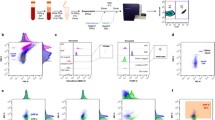Summary
The purpose of this study was to measure the binding of concanavalin A (conA) in minute regions of tissue by labelling the conA with iron dextran; then by measuring the bound iron per site by a procedure which uses atomic absorption spectrophotometry, X-ray microanalysis, and image analysis. The resulting data for a given region γ are entered into the formula:
The resulting quantity “iron at γ” is directly proportional to conA binding in that region.
For this study, three regions of rat renal cortex were compared: (1) distal tubules, collecting ducts and blood vessels; (2) glomeruli; and (3) proximal tubules.
Regional iron concentrations were: (1) Combined region (distal tubules, etc.), 0.147±0.107 μg/mg tissue; (2) glomeruli, 0.199±0.087 μg/mg tissue; and (3) proximal tubules, 1.711±0.303 μg/mg tissue.
Similar content being viewed by others
References
Bacic A, Williams ML, Clarke AF (1985) Studies on the cell surface of zoospores and cysts of the fungus Phytophthora cinnamomi: Nature of the surface saccharides as determined by quantitative lectin binding studies. J Histochem Cytochem 33:384–388
Barbi NC (1979) Quantitative methods in biological X-ray microanalysis. In: “SEM/1979/II” SEM Inc. AMF O'Hare, Chicago Illinois, p 659
Bernhard W, Avrameas S (1971) Ultrastructural visualization of cellular carbohydrate components by means of concanavalin A. Exp Cell Res 64:232–236
Capaldi MJ, Dunn MJ, Sewry CA, Dubowitz V (1985) Lectin binding in human skeletal muscle: a comparison of 15 different lectins. Histochem J 17:81–92
Goldstein JI, Newbury DE, Echlin P, Joy DC, Fiori C, Lifshin E (1981) Scanning electron microscopy and X-ray microanalysis. Plenum Press, New York
Hall TA (1979) Biological X-ray microanalysis. J Microsc 117:145–163
Hardham A (1985) Studies on the cell surface of zoospores and cysts of the fungus Phytophthora cinnamomi: the influence of fixation of patterns of lectin binding. J Histochem Cytochem 33:110–118
Hennigar RA, Schulte BA, Spicer SS (1985) Heterogeneous distribution of glycoconjugates in human kidney tubules. Anat Rec 211:376–390
Lee MC, Damjanov I (1985) Pregnancy-related changes in the human endometrium revealed by lectin histochemistry. Histochemistry 82:275–280
Lis H, Sharon N (1973) The biochemistry of plant lectins (phytohemagglutinins). Annu Rev Biochem 42:541–574
Martin BJ, Spicer SS (1974) Concanavalin A-iron dextran techniques for staining cell surface mucosubstances. J Histochem Cytochem 22:206–207
Nicolson GL, Singer SJ (1971) Ferritin-conjugated plant agglutinins as specific saccharide stains for electron microscopy: application to saccharide bound to cell membranes. Proc. Natl Acad Sci USA 68:942–945
Renau-Piqueras J, Miragall F, Cervera J (1985) Distribution of concanavalin-A receptor sites on the surface of human resting T lymphocytes. A stereological study using Concanavalin-A/colloidol gold-labelled horseradish peroxidase. Histochemistry 82:293–297
Rosenquist TH, Huff TA (1985) Lectin binding and glycosylation of the diabetic kidney. Histochemistry 83:279–284
Rosenquist TH, Rosenquist JW (1974) A procedure for the use of atomic absorption spectrophotometry in quantitative histochemistry. J Histochem Cytochem 22:104–109
Rosenquist TH (1977) A review: Atomic absorption spectrophotometry in quantitative histochemistry. Histochem J 9:127–139
Roth J (1983) Application of lectin-gold complexes for electron microscopic localization of glycoconjugates on thin sections. J Histochem Cytochem 31:987–999
Schulte BA, Spicer SS (1985) Histochemical methods for characterizing secretory and cell surface sialoglycoconjugates. J Histochem Cytochem 33:427–438
Smith SB, Revel JP (1972) Mapping of concanavalin A biding sites on the surface of several cell types. Dev Biol 27:434–448
Snedecor, GS (1962) Statistical methods. Iowa State University Press, Ames, p 46
Thompson SW (1966) Selected histochemical and histopathologic methods. Charles C Thomas, Springfield, p 480
Author information
Authors and Affiliations
Rights and permissions
About this article
Cite this article
Rosenquist, T.H., Huff, T.A. A procedure to measure concanavalin-A binding with atomic spectroscopy and X-ray microanalysis. Histochemistry 84, 61–65 (1986). https://doi.org/10.1007/BF00493422
Received:
Accepted:
Issue Date:
DOI: https://doi.org/10.1007/BF00493422




